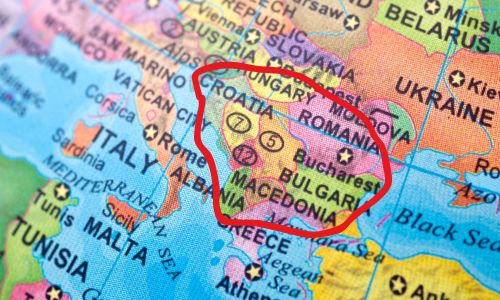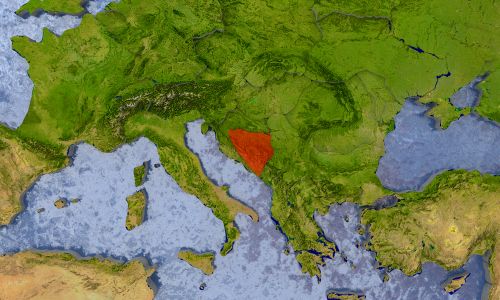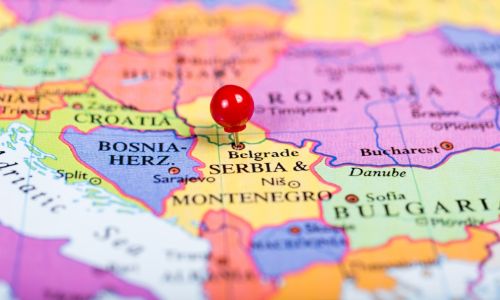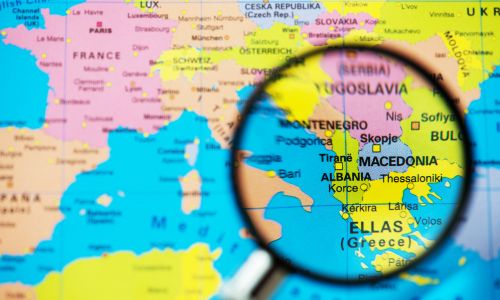Origins of the Balkan Accordion Tunes
Just like in most European countries in the early 19th century, accordions spread quickly and became folk instruments and an integral part of traditional, folklore music.
Shortly after the fall of the Ottoman Empire, the Balkan region replaced the Turkish string instruments with an accordion and popular Balkan tunes like Kolo and Sevdah were played on an accordion.

For the past 100 years, accordions became so ingrained into the Balkan culture that many people assume this musical instrument was actually invented in the Balkan region. From Slovenia to Macedonia, folklore songs and dances are simply unimaginable without an accordion sound
Sounds of Bosnian Accordion Music
Accordion music is so prevalent in Bosna and Herzegovina that many Europeans and tourists who don’t know the history of the instrument often assume that the accordion was invented in this country.

Bosnian folk songs known as Sevdah or Sevdalinke, a timeless musical genre originating in Bosnia and Herzegovina, steeped in emotion; perfectly encapsulated by the term ‘love’ when translated to Turkish.
These melodies are in most cases played on a piano accordion although some accordion virtuosos of that region play them on button accordions too. Very often accordionists are accompanied by a violine and sometimes a flute.
Sevdah, a word stemming from Turkish and Arabic roots, is so much more than just love. It embodies the longing associated with unrequited emotions and signifies melancholic enamorment or ‘love-sickness’.
This complex emotion can be found in Bosnian Sevdah music that describes an intense yearning for something lost – whether it’s a person, place or time filled with both joyous memories as well as sorrowful ones.
These melancholic tunes loaded with sentimental lyrics, with Arabesque sounding bridges and rhythms are very popular amongst the accordionists of the region and are often studied by world-renowned musicologists.
Bosnian accordion music often accompanies folk dances known as “KOLO.” These dances are similar in all republics of former Yugoslavia but Bosnian ones are influenced by elements of Turkish and even Persian music and traditional garments.
Serbian Button Accordion Melodies

The Serbian accordion is an integral part of this country’s culture! This traditional instrument, often referred to as a Dugmetara (similar in core design to the Russian Bayan) produces unique and lively music that captivates audiences.
Accordionists have been incorporating it into their folkloric soundscape for generations. Dugmetara accordion is a chromatic, six-row B-system with 5 bass tones.
The accordion holds a special place in Serbian culture, particularly as an integral part of its traditional folk music. When accompanied by trumpet and violine or a guitar it is able to create the contagious energy that fills up kafanas (coffee house or a bar) – Serbia’s beloved temples of nightlife.
Accordion music in Serbia is an integral part of celebrations, weddings, kolo dances, and weddings. Competitions amongst accordionists of all ages and skill levels are quite common in Serbia.
Folk songs and melodies in Serbia are also associated with patriotic melodies that date back to WWI era or even earlier.
While the piano accordion is widely used across Europe and North America, in Serbia its traditional counterpart reigns supreme: The Bayan Accordion or “dugmetara”. This instrument has six rows with a flat keyboard that produces five sounds for the bass.
It’s unique to this region of the world, setting it apart from other types of accordions on offer! For this reason – as well as its distinctive quadrangular shape – locals refer to it fondly by its famous name; ‘The Serbian Dugmetara’ Name is derived from Serbian word “Dugme” which translates to “button” in English.
Slovenian Folk Accordion Melodies

Slovenian folk tunes are known for their distinct Alpine and German-inspired sound. Accordions, in particular, play a major role as they accompany traditional songs, dances and melodies – offering an insight into the unique musical heritage of this former Yugoslav republic on the Balkan Peninsula.
A brief history of Slovenian accordions
The immensely popular and incredibly versatile Harmonika has a special place in history. The Steirische Harmonika, also known as the Styrian accordion, came from Windischgraz in Styria – now Slovenia.
Its origins trace back to 1878 when Franz Lubas invented its unique helikon bass reed feature. It is truly an incredible instrument that became Alpine cultures together with every sound it makes.

“The accordion is the most widespread instrument in Slovenia today. It has been used in Slovenian folk music since the second half of the nineteenth century.
People mainly played factory-produced diatonic accordions which were usually bought in Italy or Austria, and to a lesser extent, custom-made or homemade accordions.
Like elsewhere in the world, upon its arrival, the accordion drove out other folk instruments. During the interwar period, the piano accordion became popular with Slovenian musicians but in the 1960s, the diatonic accordion became widely used again.” (Quoted from Mojica Kovacic’s “The Accordion In Slovenia Today“).
Why are Slovenians so closely tied to an accordion? You can find some answers in this article. Slovenian-made accordions are primarily button, chromatic accordions but piano accordions are widely used as well.
Some of the famous Slovenian accordion brands are Zupan, Munda, and Rutar. In the video below you can hear a Slovenian folk song performed by a young accordion virtuoso.
Oberkrainer and Sterische styles and sounds
The Slovenian/Oberkrainer style accordion rhythm is a unique technique employed by Alpine-style musicians in Slovenia and Austria to provide the perfect accompaniment for trio or quintet performances.
Oberkrainer refers to a style of playing of a piano accordion characterized as “shaking” due to its dynamically altering sound; this dynamic playing between melody and rhythm forms an integral part of Austrian Oberkrainer music, generating an enchanting atmosphere that provides the backdrop for vocals singing folk songs from the Alpine region.
This style of accordion playing was developed by the legendary Slovenian accordionist Slavko Avsenik, a celebrated ethnic popular musician whose career accomplishments have solidified him as an international icon.
For over four decades, his band’s “Oberkrainer” sound captivated not only Slovenia but also Germany, Austria, Switzerland.
Piano accordions have long been used to create the traditional alpine sound of a steirische harmonika. These instruments feature an innovative 3 reed musette tuning and helikon basses, making them well-suited for authentic Alpine music styles.
Many brands specialize in creating non-casotto variants with MH (musette and helikon) tunings – perfect for the emulation of diatonic accordion tones.
Slovenian Button Accordion-Steirische Harmonika
Slovenian button accordions are known for their rich bass sound and there are quite a few specialized factories that produce these chromatic accordions across Slovenia. A common name for these gorgeous musical instruments in Slovenia is the “Frajtonarca” or “free tone” accordion.
They come with three rows of buttons on the treble side. Slovenian accordion has quite a history and it dates back to its predecessor “Styrian accordion” (diatonic, bisonoric accordion). To learn more about Slovenian accordions and their characteristic please refer to this article.
Why are Slovenians so closely tied to an accordion? You can find some answers in this article. Slovenian-made accordions are primarily button, chromatic accordions but piano accordions are widely used as well.
Some of the famous Slovenian accordion brands are Zupan, Munda, and Rutar. In the video below you can hear a Slovenian folk song performed by a young accordion virtuoso.
“The accordion is the most widespread instrument in Slovenia today. It has been used in Slovenian folk music since the second half of the nineteenth century. People mainly played factory-produced diatonic accordions which were usually bought in Italy or Austria, and to a lesser extent, custom-made or homemade accordions.
Like elsewhere in the world, upon its arrival, the accordion drove out other folk instruments. During the interwar period, the piano accordion became popular with Slovenian musicians but in the 1960s, the diatonic accordion became widely used again.” (Quoted from Mojica Kovacic’s “The Accordion In Slovenia Today“).
If you’re in the market for a traditional Slovenian or Alpine accordion, you might be confused as to whether you should go with the Steirische or Oberkrainer sounds.
Fortunately, the two sounds are quite distinct, so it’s not hard to identify them if you take a listen to some of the Alpine accordionists and their recordings.
Ultimately, it all comes down to personal preference; however, keep in mind that a change in tuning may affect the construction weight of your instrument and also its price range. But if both types of sound suit you and your budget is limited—why not go for whichever is cheaper?
Accordion music in Croatia

Even though Croatia is one of the five republics of the former Yugoslavia where accordions and their music dominate the folklore scene, the traditional string folk instrument “tambura” retained popularity.
Nevertheless, the accordion is a very popular musical instrument in Croatia today and Croatian accordionists are amongst the best in the world.
While button (bayan or dugmetara) accordions are popular in neighboring Serbia, Croatian accordionists predominantly play the piano accordions.
In 2022 World Accordion Federation awarded the Croatian accordion orchestra “Brodski Harmonikasi” with a gold medal for their unparalleled performance.
Street accordionists aka buskers are very popular in Croatia and can often be seen entertaining the crowds on the streets of Zagreb. They are often gypsy performers who play various Balkan folk tunes.
Accordion in Macedonian Folk music
Macedonia is a small country located in the Balkans region of Southeast Europe, known for its rich history, splendid natural beauty, and welcoming people. It has always been an important crossroads between Europe, Asia, and Africa, with a strategic geographical position that has shaped its destiny for centuries.

The basic foundation of traditional Macedonian music comes from several distinct cultures such as Byzantine, Turkish, and Slavic. Due to its geographical location and through centuries of invasions, Macedonian music has been influenced by several cultures and traditions.
The roots of Macedonian Folklore music lie in rural areas in the form of epic songs that describe heroic feats and ancient traditions and beliefs.
The beauty of Macedonian folk music lies in its ability to evoke emotions and memories with its melodies. This music is incredibly diverse, ranging from slow ballads to lively and upbeat tracks. The accordion’s versatility fits into all sub-genres and produces varying sounds, bringing unique qualities to the music.
Musicians and accordionists around the world have drawn inspiration from Macedonian music, contributing to the adaptation and spread of this music genre.
Famous Macedonian Accordionists
The accordion, also known as the harmonica, is an essential instrument in crafting Macedonian folk music. Its versatility and polyphonic sounds add depth and complexity to the music, creating a unique blend of Macedonian sounds.
Accordions are readily available in most Macedonian music shops, and many people learn how to play the instrument from a young age, leading to the emergence of several skilled accordionists in the region. Below are just a few of many noteworthy Macedonian accordion virtuosos.
Kocho Petrovski
Discover the captivating musical journey of Kocho Petrovski, a renowned accordionist who has left an indelible mark on folk music in Macedonia and the entire Balkan region.
Emerging after World War 2, Petrovski pioneered a unique style of ornamental playing, revolutionizing folk music as we know it. His innovative techniques and mesmerizing melodies have influenced countless contemporary accordionists throughout the former Yugoslavia.
Experience the enchanting legacy of Kocho Petrovski and unlock the secrets of his musical genius.
Sasko Velkov
Meet Sasko Velkov, the talented Macedonian accordion virtuoso hailing from Kocana. With a natural gift for music, Sasko’s talent was quickly recognized, leading him to win the prestigious “First Accordion” competition in Macedonia back in 1990.
Since then, he has had the honor of playing alongside renowned folk music stars from the Balkans, showcasing his exceptional skills on the accordion. Sasko’s musical journey is on a constant upward trajectory, as he continues to expand his career.
Some final words
The vibrant and diverse folklore music scene, in the Balkans is a blend of Oriental melodies and rhythms. It weaves together a tapestry that reflects the regions diverse cultural heritage, influenced by a complex history of intercultural interactions.
Among all the instruments the accordion holds a place as it is considered the backbone of this tradition. Its versatility and expressive qualities serve as a bridge between Alpine and Oriental musical influences making it one of the defining elements in folk ensemble sounds.
With its resonating chords and lively melodies the accordion brings the music to life adding cadences that unfold like chapters, in a story. This creates an atmosphere where Balkan folklore music becomes a celebration of harmony and cherished heritage.
Dino is a hobbyist accordionist who loves music, photography, architecture, design and a slew of other fun things. He decided to launch this blog due to an increasing popularity of the accordion. He learned how to play the accordion by ear as a child and then progressed on to keyboards and eventually a drum set. He grew up in the Balkans and now lives in California where he occasionally plays the accordion at birthday parties and NYE celebrations. He now shares his love for the accordion through this blog.






Leave a Reply